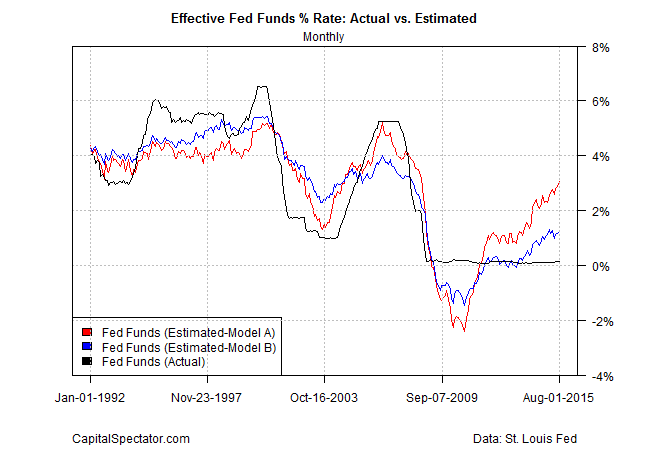The Federal Reserve may or may not raise interest rates today—the mystery will be solved when today’s policy announcement hits the streets at 2:00 pm eastern. Meanwhile, what’s the case for squeezing liquidity, if only slightly? US economic growth, after all, has been sluggish lately, which inspires Goldman Sachs CEO Lloyd Blankfein (among others) to recommend that the central bank delay the first hike in over a decade. The economic data “is not compelling to raise interest rates right now,” he says. An open-and-shut case? Not quite, which explains the recent obsession with analyzing/forecasting the Fed’s decision that’s finally upon us. So, how might the monetary mavens rationalize raising rates today? By focusing on the specific data points that support a hike. Although Blankfein suggests otherwise, there are some indicators that suggest that tighter policy is appropriate. To be precise, certain models are a hawk’s best friend for arguing that it’s time to pull the trigger.
Exhibit A is the Taylor Rule, which the St. Louis Fed describes as “a simple formula that [economics professor] John Taylor devised to guide policymakers. It calculates what the Federal funds rate should be, as a function of the output gap and current inflation.” Recent estimates via the Taylor Rule tell us that a higher Fed funds rate is warranted—something on the order of 2.5% (blue line in chart below), which is far above the current zero-to-0.25% target (red line).
A simple linear regression also offers cover for arguing that a rate hike is needed. Let’s run the econometric grinder on the effective Fed funds rate in context with two proxies for the central bank’s primary mandate—keeping inflation low/stable and maximizing employment. The proxies: the year-over-year change in unadjusted core CPI and the seasonally adjusted monthly levels of the unemployment rate. Both offer updates through last month. The result? Fed funds should be sharply higher, according to this model: a bit over 3% (red line in chart below), based on monthly data through August 2015.
Let’s tweak the linear regression model a bit by adding two other key indicators with fresh numbers through last month: industrial production and retail sales. The resulting four-factor model for estimating the Fed funds rate calls for a hike today as well, albeit to a relatively modest 1.25% (blue line)–well below the first model’s recommendation.
Janet Yellen and company are no doubt looking at a range of models, some of which are probably advising that’s it’s time to nudge the policy rate higher (or at least drop the zero from the current zero-to-0.25% target rate).
If rates do rise today, it’s likely to be small–anything above 25 basis points would certainly be a surprise. Models may inform the hawkish view, but there are limits. In any case, we’ve already reached a new milestone. Never have so many spent so much time and effort on analyzing the outlook for such a small rate hike.



Pingback: 09/17/15 – Thursday’s Interest-ing Reads | Compound Interest-ing!